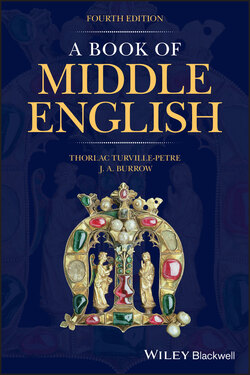Читать книгу A Book of Middle English - J. A. Burrow - Страница 79
5.7 Negation
ОглавлениеIn earlier texts the usual way of negating a verb was to place ne (or no/na) immediately in front of it, and indeed this practice continued throughout the period: I ne can ne I ne mai, ‘I do not know how to nor am I able to’, 1/33; ne wonde / þis aventure for to frayn, ‘don’t hesitate to attempt this adventure’, 9/488–9. Ne was run together with have, wil and parts of be beginning with a vowel or w‐: e.g. nadde, nil, nis, nere (4.5.7–8).
Ne could be reinforced by another negative word elsewhere in the sentence. The commonest was nouʒt, originally a noun meaning ‘nought’ or ‘nothing’, which developed into the adverb not: he no schuld nouʒt fram hem go, ‘he would not go from them’, 5/225; with the subject following the verb: ne reche ich noʒt, ‘I don’t care’, 2/58; with noʒt modifying another adverb, wel: his nest noʒt wel he ne bihedde, ‘he did not guard his nest well’, 2/102.
From the fourteenth century it became common to negate the verb with not alone, usually following the verb: I know not þe, ‘I don’t know you’, 9/400; Arthure wolde not ete, 9/85. In verse, where word‐order is more flexible, bringing noʒt forward gives it additional emphasis: þat noʒt hit yow falles, ‘that it is not fitting for you’, 9/358. The modern construction with auxiliary ‘do not’ was not fully established until the seventeenth century.
The notions that multiple negation, as in ‘he ain’t been nowhere’, is substandard, and that ‘two negatives make a positive’, have no historical basis. In Middle English piling up of negatives is very common, and its purpose is to reinforce the negative. Notable examples are: never him nas wers for noþing, ‘he was never more distressed about anything’, 5/98; ne isæh nævere na man selere cniht nenne, ‘no‐one had ever seen a better knight’, 3/28.
